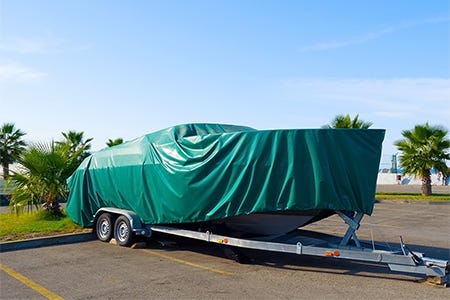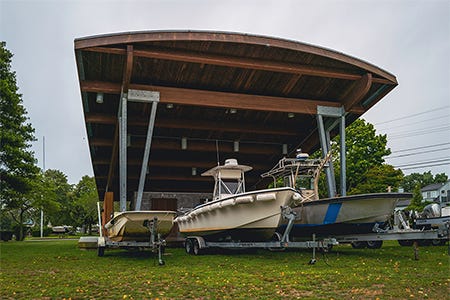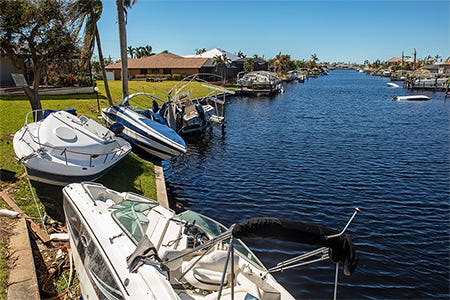

If you store your boat near the coast, dealing with storms and hurricanes should be a major consideration. Even inland, strong summer storms can produce damaging winds, hail, tornados and waterspouts that can damage or destroy your boat and lead to long-term aggravation and significant financial loss. Even though major storms are a relatively predictable reality, many boaters get a nasty surprise when they find themselves on the wrong side of the impact zone.
You can avoid a great deal of frustration — and cost — by recognizing the common myths that many boat owners fall into. Below are the most common — and costly — myths to avoid:
Contents
- 1. Myth: “Insurance will take care of it.”
- 1.1 Total Loss Vs. Repairable Damage
- 2. Myth: “There’s nothing I can do about it.”
- 2.1 Have a Plan Before you Need It
- 2.2 Inland, High Ground Is Best
- 2.3 Haulouts and Storing “On the Hard”
- 3. Myth: “My marina has me covered.”
- 3.1 The Marina’s Primary Focus
- 4. Other Storm Considerations
- 4.1 To Cover or Not to Cover
- 4.2 Trailer preparation
- 4.3 Stripping down
- 4.4 Boat Lifts
- 5. After the Storm
- 6. Have the Right Insurance Policy
Myth: “Insurance will take care of it.”
The vast majority of boat owners carry some form of damage insurance on their boats, and a good policy can limit the loss you will take if your boat is damaged or destroyed in a hurricane or major storm. However, the idea that your policy will “take care of it” is a major fallacy.
Consider these factors BEFORE your boat is involved in a storm:
Total Loss Vs. Repairable Damage
Many boat owners assume that, if their boat is involved in a storm, that it will be a total loss and they will simply receive a check to go get a new boat. The reality is that your insurance policy will likely have a deductible, leaving you with a financial gap between the check you receive and the full value of the boat you lost. Additionally, if the replacement boat you are looking at is new, it will likely cost significantly more than the check you receive. Simply said, it’s better to avoid the damage than to get the check.
In many cases, your boat will be damaged, but the damage will be repairable. Again, the insurance company will cover a portion of the repair cost (minus your deductible), but you now face two problems:
1) the decreased value of your boat due to the fact it’s been repaired, and
2) the aggravation, uncertainty and time it takes to get the boat properly repaired. On this last point, boat repairs are not always straightforward; good, reliable, high-quality repair shops are in high demand — especially after a major storm. You may very well find yourself having to choose between getting your boat fixed quickly and getting your boat fixed properly. Insurance is there if damage or loss is inevitable, but it is far preferable to avoid storm damage in the first place.
Myth: “There’s nothing I can do about it.”
Once you understand that it is far better to avoid damage or loss than to have to use your insurance, the next question becomes, “What can I do?” Many boat owners feel a sense of helplessness or inevitability when a major storm is barreling their way.
Let’s face it, if you live in the potential “cone” of a hurricane, protecting your boat may not be your highest priority. Your home and the lives of your family will take precedence. The good news is, however, that a few very simple actions taken long before the storm ever forms can go a long way to keeping your boat safe.
Have a Plan Before you Need It
When a hurricane is barreling your way, you have a lot on your mind. You need to have a plan already in place so that you know what steps to take, who to call, and what to do. Insurance statistics show vastly different outcomes in damage claims when boat owners have a simple plan versus when they don’t. That’s why, over the past few years, more and more insurance companies require one.
You need to have a plan already in place so that you know what steps to take.
Take the time to consider what you can do to protect your boat while the weather is calm. With a little consideration, you will be amazed at how easy it can be to keep your boat out of harm’s way when the storm arrives.
Inland, High Ground Is Best
If there is any possibility that your boat can be trailered inland, it has a much better chance for protection than being at a marina or near the water. If you don’t have a trailer, you might consider getting one, or at least locking down one to rent or use.
Remember, the cost of a trailer to keep your boat out of harm’s way is likely less than your deductible will be if your boat is damaged.
Once a trailer has been secured, spend time finding and arranging for temporary storage in a safe location inland that is away from trees or, ideally, in a covered garage or metal building. If you have a relative, friend, or even an acquaintance with open pasture, talk to them about potential arrangements if a storm comes your way.
Haulouts and Storing “On the Hard”
For larger boats, trailering may not be an option, but leaving your boat in a marina should be your last resort. The best solution is having the boat hauled out and stored “on the hard,” meaning on jack stands with the boat heavily anchored to the ground.
This option is the best way to protect your boat, but requires significant advance planning and arrangements, and you need a reliable company to do it. When a hurricane is headed your way, the demand for these services will be intense, so you need to make sure your arrangements will be executed as agreed. While the cost may be significant, it is often less than the insurance deductible, and may actually reduce the deductible if damage still occurs.
Myth: “My marina has me covered.”
Many boat owners operate under a false sense of security when their boat is stored at a marina. While marinas will take some precautions to minimize damage, relying on them to protect your boat is a recipe for disappointment.
Older marinas with fixed docks or low pilings are particularly susceptible to storm damage, and as a result, damage to your boat. More recently built marinas may have taller pilings and newer floating docks that can handle storm surge and protect boats relatively well, but these tend to be both rare and expensive.
The Marina’s Primary Focus Will Be Protecting the Marina
Your marine will be protecting the buildings, docks, equipment and fuel tanks — not your boat. To a large degree, marinas rely on boat owners — and boat owners’ insurance policies — to avoid or cover damage to individual boats. In fact, many marinas require boat owners to have a formal plan for preparing or even removing their boats for a hurricane, so it is important that you understand your responsibilities versus theirs.
It is important that you understand your responsibilities versus theirs.
Even with the best plan and best preparations, keep in mind that protecting your own boat at the marina may not be enough. Once a storm hits, damage to the marina or surrounding boats may make your boat inaccessible for weeks or even months.
This is particularly true for dry stacks built before Hurricane Andrew, and a quick search of hurricane aftermath pictures will demonstrate why. There are some exceptions, but unless your marina’s dry stack touts its hurricane resistance, it is best to move your boat to high, solid ground if at all possible. The reality is that, in most cases, marinas are simply the worst places to have your boat during a hurricane.
Other Storm Considerations
Having a plan in advance to get your boat into the best possible location and situation is the first step, but there are many other questions boat owners face when trying to give their boats the best possible chance in a major storm. Consider these tips when making your plan:
To Cover or Not to Cover
In normal conditions, boat covers offer a great deal of protection against damaging UV rays, hail and small debris.
However, in major storms, the quality, fit and installation of the cover should determine whether it is better to have it on or to keep it off the boat. A high quality, custom cover, made with heavy material (like Sunbrella fabric), that is properly secured to the boat or trailer can protect your boat from hail and flying debris, but keep in mind that it also adds wind resistance, potentially causing your boat to be flipped over in intense winds.
If you choose to cover your boat, make sure the boat and trailer are secured to the ground using hurricane spikes or other options. Generic, loose-fitting covers, or covers made with lighter materials can come loose and/or tear and end up battering your boat as they flap in the wind. You may be better served by removing them.
Trailer preparation
There is a “tip” floating around the internet encouraging boat owners to fill their hull partially with water before a hurricane to keep the boat from being tipped over in the wind. This is a terrible idea for many reasons, but the most obvious is that doing so requires you to keep the plug in. The already flooded bilge will continue to collect water, and as the heavy rains arrive, the weight can cause significant and potentially catastrophic damage to your trailer and your hull.
If you are keeping your boat on the trailer during a hurricane, there are some things you can do to keep it safe. Lowering the air pressure in the tires, stabilizing the trailer with concrete blocks, strapping the boat to the trailer and the trailer to the ground with hurricane spikes can go a long way towards keeping your boat stable and safe in even the strongest gusts.
Stripping down
Take time before the storm arrives to remove everything possible from your boat. This obviously includes any loose equipment that can batter the boat or fly away, but also includes electronics, canvas T-tops, Bimini tops, enclosures, cushions, tillers and anything else that could be impacted by strong gusts, hail or flying debris.
Don’t forget to remove your plug and latch any hatches and doors that could be opened by the wind.
Boat lifts
If marinas are a bad option for hurricane storage, keeping your boat on a boat lift is even worse. While the dock, lift, and boat may be sturdy enough to handle the wind, a strong storm surge will likely submerge the entire structure, exposing it to significant wave damage and likely destroying every part of it. Your dock and lift have a better chance of survival without your boat in the equation.
After the Storm
If your boat is involved in a major storm or hurricane, your insurance company will evaluate any potential damage to your boat. It is important that you take an active role in this process to ensure the full extent of the damage is properly assessed. Damage to engines, electrical systems and equipment may not be easily identified, so having a good surveyor, mechanic or boat repair shop take a closer look is always a good idea.
A boat that is partially submerged may appear to be completely undamaged, but the flooded bilge can wreak havoc on wiring, electrical connections and electronics that may not present issues immediately. Water seepage into fuel or oil systems can destroy an engine, and if your engine is even partially submerged, it needs to be addressed fully and properly as soon as possible.
Part of your storm preparation plan should include identifying reputable repair shops and mechanics before you need them. Having a relationship with these shops before a storm can put you ahead of a long line of other boat owners if there is extensive damage in your area.
Have the Right Insurance Policy
No matter how good your insurance policy is, you are always far better off avoiding damage to your boat than you will be if you have to file a claim. The financial loss caused by insurance deductibles, improper coverage, and the devaluation caused by repairs is only part of the equation. Getting your boat repaired or replaced after a storm can be a maddening exercise that can keep you off the water long after the other effects of the storm have been cleaned up.
Plan ahead for damaging storms when the weather is good. Review and update your insurance policy, then take every step possible to avoid needing it. Once a storm has formed, it is often too late to take the steps needed to protect your investment, your boat and your peace of mind.



